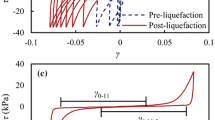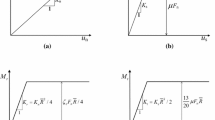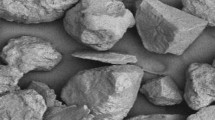Abstract
This paper presents a numerical investigation on the strain localization of an idealized sand in biaxial compression tests using the distinct element method (DEM). In addition to the dilatancy and material frictional angle, the principal stress field, and distributions of void ratio, particle velocity, and the averaged pure rotation rate (APR) in the DEM specimen are examined to illustrate the link between microscopic and macroscopic variables in the case of strain localization. The study shows that strain localization of the granular material in the tests proceeds with localizations of void ratio, strain and APR, and distortions of stress field and force chains. In addition, both thickness and inclination of the shear band change with the increasing of axial strain, with the former valued around 10–14 times of mean grain diameter and the later overall described by the Mohr-Coulomb theory.
Similar content being viewed by others
References
Jiang Mingjing, Shen Zhujiang. State-of-arts review on strain localisation (shear band) of soils. In: Proceedings of Third Chinese Youth Conference on Geomechanics and Geo-Engineering. Nanjing: Hehai University Publication, 1998, 134–149 (in Chinese)
Labuz J, Drescher A. Bifurcations and Instabilities in Geomechanics. Netherlands: Swets & Zeitlinger, 2003
Yin J H, Li X S, Yeung A T, Desai C S. In: The International Workshop on Constitutive Modelling Development, Implementation, Evaluation, and Application, Hong Kong. 2007
Rudnicki J W, Rice J R. Conditions for localization of deformation in pressure-sensitive dilatant materials. Journal of the Mechanics and Physics of Solids, 1975, 23: 371–394
Vardoulakis I. Shear band inclination and shear modulus of sand in biaxial tests. International Journal for Numerical and Analytical Methods in Geomechanics, 1980, 4: 103–119
Papamichos E, Vardoulakis I. Shear band formation in sand according to non-coaxial plasticity model. Géotechnique, 1995, 45: 649–661
Vardoulakis I, Sulem J. Bifurcation Analysis in Geomechanics. London: Blackie Academic and Professional, 1995
Hicher P Y, Wahyudi H, Tessied D. Micro-structural analysis of strain localization in clay. Computers and Geotechnics, 1994, 16: 205–222
Jiang M J, Shen Z J. Microscopic analysis of shear band in structured clay. Chinese Journal of Geotechnical Engineering, 1998, 20(2): 102–108
Jiang M J, Hongo T, Fukuda M. Pre-failure behaviour of deep-situated Osaka clay. China Ocean Engineering, 1998, 12(4): 453–465
Jiang M J, Peng L C, Zhu H H, Lin Y X, Huang L J. Macro- and micro properties of two natural marine clays in China. China Ocean Engineering, 2009, 23(2): 329–344
Higo Y, Oka F, Jiang M J, Fujita Y. Effects of transport of pore water and material heterogeneity on strain localization of fluid-saturated gradient-dependent viscoplastic geomaterial. International Journal for Numerical and Analytical Methods in Geomechanics, 2005, 29: 495–523
Thomas T. Plastic Flow and Fracture in Solids. Elsevier: Academic Press. 1961
Rice J R, Rudnicki J W. A note on some features of theory of localization of deformation. International Journal of Solids and Structures, 1980, 16: 597–605
Vardoulakis I. Equilibrium bifurcation of granular earth bodies. In: Advances in Analysis of Geotechnical Instabilities. Waterloo: University of Waterloo Press, 1978, 65–119
Vardoulakis I. Bifurcation analysis of the triaxial test on sand samples. Acta Mechanica, 1979, 32: 35–54
Vardoulakis I. Constitutive properties of dry sand observable in the triaxial test. Acta Mechanica, 1981, 38: 219–239
Vardoulakis I. Rigid granular plasticity model and bifurcation in the triaxial test. Acta Mechanica, 1983, 49: 57–79
Muhlhaus H B, Vardoulakis I. The thickness of shear bands in granular materials. Geotechnique, 1987, 37: 271–283
Vardoulakis I. Shear banding and liquefaction in granular materials on the basis of Cosserat continuum theory. Archive of Applied Mechanics, 1989, 59(2): 106–113
Bazant Z P. Softening instability: Part I- Localisation into a planar band. Journal of Applied Mechanics, ASME, 1988, 55: 517–522
Arthur J R F, Dunstan T. Rupture layers in granular media. In: Proceedings UTAM Conference on Deformation and Failure of Granular Materials. Rotterdam: Balkema, 1982, 453–459
Drescher A, Vardoulakis I. Geometric softening in triaxial tests on granular material. Geotechnique, 1982, 32(4): 291–303
Lade P V. Localization effects in triaxial tests on sand. In: Proceedings UTAM Conference on Deformation and Failure of Granular Materials. Rotterdam: Balkema, 1982, 461–471
Hettler A, Vardoulakis I. Behaviour of dry sand tested in a large triaxial apparatus. Geotechnique, 1984, 34(2): 183–198
Han C. Localisation of deformation in sand. Dissertation for the Doctoral Degree. University of Minnesota, 1991
Han C, Drescher A. Shear bands in biaxial tests on dry coarse sand. Soils and Foundations, 1993, 33(1): 118–132
Otani J, Mukunoki T, Obara Y. Characterization of Failure and Density Distribution in Soils Using X-Ray CT Scanner. In Proceedings of China-Japan Joint Symposium on Resent Development of Theory & Practice in Geotechnology. Shanghai, 1997, 45–50
Nemat-Nasser S, Okada N. Radiographic and microscopic observation of shear bands in granular materials. Geotechnique, 2001, 51(9): 753–765
Harris W W, Viggiani G, Mooney M A, Finno R J. Use of stereo-photogrammetry to analyze the development of shear bands in sand. Geotechnical Testing Journal, ASTM, 1995, 18(4): 405–420
White D J, Take W A, Bolton M D. Soil deformation measurement using particle image velocimetry (PIV) and photogrammetry. Geotechnique, 2003, 53(7): 619–631
Bazant Z P, Kim S S. Plastic fracturing theory for concrete. Mechanical Engineering, ASCE, 1979, 105: 467–478
Frantziskonis G, Desai C S. Constitutive model with strain softening. International Journal of Solids and Structures, 1987, 23(6): 733–750
Oritz M, Leroy Y, Needleman A. A finite element method for localised failure analysis. Computer Methods in Applied Mechanics and Engineering, 1987, 61: 189–214
Pietruszczak S, Niu X. On the description of localised deformation. International Journal for Numerical and Analytical Methods in Geomechanics, 1993, 17: 791–805
Hoeg K. Finite element analysis of strain-softening clay. Journal of the Soil Mechanics and Foundations, ASCE, 1972, 98(SMI): 43–58
Lo K Y, Lee C F. Stress analysis and slope stability in strains-oftening materials. Geotechnique, 1973, 23(1): 1–11
Yatomi C, Yashima A, Izuka A, Samo I. General theory of shear bands formation by a non-coaxial cam-clay model. Soils and Foundations, 1989, 29(3): 41–53
Yatomi C, Yashima A, Izuka A, Samo I. Shear bands formation numerically simulated by a non-coaxial cam-clay model. Soils and Foundations, 1989, 29(4): 1–3
Shuttle D A, Smith I M. Localization in the presence of excess pore water pressure. Computers and Geotechnics, 1990, 8: 87–99
Pijaudier-Cabot G., Bazant A P. Nonlocal damage theory. Journal of Engineering Mechanics, ASCE, 1987, 113: 1512–1533
Bazant A P, Pijaudier-Cabot G, Non-local continuum damage, localisation instability and convergence. Journal of Applied Mechanics, 1988, 55: 287–293
Bazant A P, Lin F B. Non-local yield limit degradation. International Journal for Numerical Methods in Engineering, 1988, 26: 1805–1823
de Borst R, Muhlhous H B. Gradient dependent plasticity formulation and algorithmic aspects. International Journal for Numerical Methods in Engineering, 1992, 35: 521–539
de Borst R. Simulation of strain localization: a reappraisal of the Cosserat continuum. Engineering Computations, 1991, 8: 317–332
de Borst R. A generalization of J2 -flow theory for polar continua. Computer Methods in Applied Mechanics and Engineering, 1993, 103: 347–362
Steinmann P. Theory and numerics of ductile micropolar elastoplastic damage. International Journal for Numerical Methods in Engineering, 1995, 38: 583–606
Tejchman J, Bauer E. Effect of cyclic shearing on shear localisation in granular bodies. Granular Matter, 2004, 5: 201–212
Tejchman J. Influence of a characteristic length on shear zone formation in hypoplasticity with different enhancements. Computers and Geotechnics, 2004, 31(8): 595–611
Tejchman J, Niemunis A. FE-studies on shear localization in an anisotropic micro-polar hypoplastic granular material. Granular Matter, 2006, 8: 205–220
Cundall P A, Strack O D L. Discrete numerical model for granular assemblies. Geotechnique, 1979, 29: 47–65
Ting JM, Corkum B T, Kauffman C R, Greco C. Discrete numerical model for soil mechanics. Journal of Geotechnical and Geoenvironmental Engineering, ASCE, 1989, 115(3): 379–398
Rothenburg L, Bathurst R J. Micromechanical features of granular assemblies with planar elliptical particles. Geotechnique, 1992, 42(1): 79–95
Bardet J P. Observations on the effects of particle rotations on the failure of idealized granular materials. Mechanics of Materials, 1994, 18: 159–182
Kuhn M R. Structured deformation in granular materials. Mechanics of Materials, 1999, 31(6): 407–429
Ng T T. Fabric evolution of ellipsoidal arrays with different particle shapes. Journal of Engineering Mechanics, 2001, 127(10): 994–999
Thornton C. Numerical simulation of deviatoric shear deformation of granular media. Geotechnique, 2000, 50(1): 43–53
Jiang M J, Harris D, Yu H S. Kinematic models for non-coaxial granular materials, Part II: Evaluation. International Journal for Numerical and Analytical Methods in Geomechanics, 2005, 29(7): 663–689
Kuhn M R, Mitchell J K. New perspectives on soil creep. Journal of Geotechnical and Geoenvironmental Engineering, 1993, 119(3): 507–524
Jiang M J, Leroueil S, Konrad J M. Insight into shear strength functions of unsaturated granulates by DEM analyses. Computer & Geotech, 2004, 31(6): 473–489
Jiang M J, Lerouil S, Konrad J M. Yielding of microstructured geomaterial by DEM analysis. Journal of Engineering Mechanics, ASCE, 2005, 131(11): 1209–1213
Jiang M J, Yu H S. Leroueil S. A simple and efficient approach to capturing bonding effect in naturally-microstructured sands by discrete element method. International Journal for Numerical Methods in Engineering, 2007, 69: 1158–1193
Utili S, Nova R. DEM analysis of bonded granular geomaterials. International Journal for Numerical and Analytical Methods in Geomechanics, 2008, 32(17): 1997–2031
Delenne J Y, El Youssoufi M S, Cherblanc F, Beneet J C. Mechanical behaviour and failure of cohesive granular materials. International Journal for Numerical and Analytical Methods in Geomechanics, 2004, 28: 1577–1594
Wang Y H, Leung S C. A particulate scale investigation of cemented sand behaviour. Canadian Geotechnical Journal, 2008, 45: 29–44
Jiang M J, Yu H S, Harris D. Bond rolling resistance and its effect on yielding of bonded granulates by DEM analyses. International Journal for Numerical and Analytical Methods in Geomechanics, 2006, 30(7): 723–761
Wang Y H, Leung S C. Characterization of cemented sand by experimental and numerical investigations. Journal of Geotechnical and Geoenvironmental Engineering, ASCE, 2008, 134(7): 992–1004
Jiang M J, Yu H S, Harris D. Discrete element modelling of deep penetration in granular soils. Journal for Numerical and Analytical Methods in Geomechanics, 2006, 30(4): 335–361
Jiang M J, Zhu H H, Harris D. Classical and nonclassical kinematic fields of two-dimensional penetration tests on granular ground by discrete element method analyses. Granular Matter, 2008, 10: 439–455
Jiang M J, Harris D, Zhu H H. Future continuum models for granular materials in penetration analyses. Granular Matter, 2007, 9: 97–108
Jiang M J, Yu H S. An interpretation of the internal length in Chang’s couple-stress continuum for bonded granulates. Granular Matter, 2007, 9: 431–437
Bardet J P, Proubet J. A numerical investigation of the structure of persistent shear bands in granular media. Geotechnique, 1991, 41: 599–613
Iwashita K, Oda M. Rolling resistance at contacts in simulation of shear band development by DEM. Journal of Engineering Mechanics, ASCE, 1998, 124: 285–292
Iwashita K, Oda M. Micro-deformation mechanism of shear banding process based on modified distinct element. Powder Technology, 2000, 109: 192–205
Oda M, Iwashita K. Study on couple stress and shear band development in granular media based on numerical analyses. International Journal of Engineering Science, 2000, 38: 1713–40
Jiang M J, Yu H S, Harris D. Kinematic variables bridging discrete and continuum granular mechanics. Mechanics Research Communications, 2006, 33: 651–666
Jiang M J, Harris D, Yu H S. Kinematic models for non-coaxial granular materials, Part I: theories. International Journal for Numerical and Analytical Methods in Geomechanics, 2005, 29(7): 643–661
Itasca Consulting Group Inc. Particle Flow Code in 2 Dimensions, version 3.1. Minnesota, USA, 2004
Jiang M J, Konrad J M, Leroueil S. An efficient technique for generating homogeneous specimens for DEM studies. Computers and Geotechnics, 2003, 30(7): 579–597
Kuhn M R. A flexible boundary for three-dimensional DEM particle assemblies. Engineering Computations, 1995, 12: 175–183
Schofield A N, Wroth C P. Critical State Soil Mechanics. London: McGraw-Hill, 1968
Ting J M, Meechum L R, Rowell J D. Effect of particle shape on the strength and deformation mechanism of ellipse-shaped granular assemblages. Computer Engineering, 1995, 12: 99–108
Sawada S, Pradhan T B S. Analysis of anisotropy and particle shape by distinct element method. In: Siriwardane H J, Zaman M M, eds. Computer Methods and Advancements in Geomechanics. Rotterdam: Balkema; 1994, 665–670
Thomas P A, Bray J D. Capturing nonspherical shape of granular media with disk clusters, Journal of Geotechnical and Geoenvironmental Engineering ASCE, 1999, 125: 169–178
Ullidtz P. Modelling of granular materials using the discrete element method. In: Proceedings of 8th International Conference on Asphalt Pavements, University of Washington, 1997, 757–769
Jiang M J, Yu H S, Harris D. A novel discrete model for granular material incorporating rolling resistance. Computers and Geotechnics, 2005, 32(5): 340–357
Jiang M J, Leroueil S, Zhu H H, Yu H S, Konrad J M. Two-dimensional discrete element theory for rough particles. International Journal of Geomechanics, ASCE, 2009, 9(1): 20–33
Author information
Authors and Affiliations
Corresponding author
Rights and permissions
About this article
Cite this article
Jiang, M., Zhu, H. & Li, X. Strain localization analyses of idealized sands in biaxial tests by distinct element method. Front. Archit. Civ. Eng. China 4, 208–222 (2010). https://doi.org/10.1007/s11709-010-0025-2
Received:
Accepted:
Published:
Issue Date:
DOI: https://doi.org/10.1007/s11709-010-0025-2




